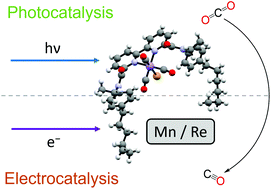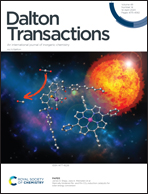Sterically hindered Re- and Mn-CO2 reduction catalysts for solar energy conversion†
Abstract
Novel molecular Re and Mn tricarbonyl complexes bearing a bipyridyl ligand functionalised with sterically hindering substituents in the 6,6′-position, [M(HPEAB)(CO)3(X)] (M/X = Re/Cl, Mn/Br; HPEAB = 6,6′-{N-(4-hexylphenyl)-N(ethyl)-amido}-2,2′-bipyridine) have been synthesised, fully characterised including by single crystal X-ray crystallography, and their propensity to act as catalysts for the electrochemical and photochemical reduction of CO2 has been established. Controlled potential electrolysis showed that the catalysts are effective for electrochemical CO2-reduction, yielding CO as the product (in MeCN for the Re-complex, in 95 : 5 (v/v) MeCN : H2O mixture for the Mn-complex). The recyclability of the catalysts was demonstrated through replenishment of CO2 within solution. The novel catalysts had similar reduction potentials to previously reported complexes of similar structure, and results of the foot-of-the-wave analysis showed comparable maximum turnover rates, too. The tentative mechanisms for activation of the pre-catalysts were proposed on the basis of IR-spectroelectrochemical data aided by DFT calculations. It is shown that the typical dimerisation of the Mn-catalyst was prevented by incorporation of sterically hindering groups, whilst the Re-catalyst undergoes the usual mechanism following chloride ion loss. No photochemical CO2 reduction was observed for the rhenium complex in the presence of a sacrificial donor (triethylamine), which was attributed to the short triplet excited state lifetime (3.6 ns), insufficient for diffusion-controlled electron transfer. Importantly, [Mn(HPEAB)(CO)3Br] can act as a CO2 reduction catalyst when photosensitised by a zinc porphyrin under red light irradiation (λ > 600 nm) in MeCN : H2O (95 : 5); there has been only one reported example of photoactivating Mn-catalysts with porphyrins in this manner. Thus, this work demonstrates the wide utility of sterically protected Re- and Mn-diimine carbonyl catalysts, where the rate and yield of CO-production can be adjusted based on the metal centre and catalytic conditions, with the advantage of suppressing unwanted side-reactions through steric protection of the vacant coordination site.

- This article is part of the themed collections: Spotlight Collection: Photoinduced redox chemistry and Breaking bonds over many timescales: in celebration of Robin Perutz’s 70th birthday


 Please wait while we load your content...
Please wait while we load your content...